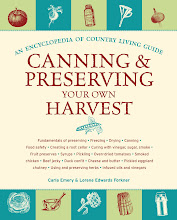
Making Dipped Candles: Lay sheets of paper under the candle rods and all over where you expect to be working, in order to protect your floors. This is very time-consuming and tends to make a mess. To work with a small amount of tallow or wax, you need a tall container, since you can't make an 8-inch candle from a 6-inch container. A 2-inch diameter would be sufficient; use metal if possible.

Dipped Beeswax Candles:
Dipped candles use beeswax more economicaly than molded ones. Have ready 2 containers. One has your melted wax in it. The other contains ice water. You can dip 6 or 8 at a time if you have a holder that will suspend that many wicks at once. You dip in the wax and then in the ice water. Then dip in the wax again, then in the ice water again, and so on until you have your candle where you want it.
More Dipping Tips: Tying a small weight (such as a little steel bolt) to the bottom of the wick will help keep it straight. After 1 or 2 dips, pull wick straight. Another hint is to alternate dips into the hot wax with dips into cool water to speed cooling. But you can't dip into the wax again until the candle is dry (you can wipe it dry). About 30 dips make an average candle.
Color and Scent: You can color your candles and scent them the same way as you do soap, but with even more freedom since you aren't going to use the results on your skin. For coloring you can use crayons. You can't use food coloring because it is water-based and won't combine with the wax. Special candle-wax colorings, scentings, and all kinds of arty possibilities can be bought from craft suppliers.
Cooling and Storing Candles: Don't cool candles in the refrigerator or freezer. They crack and become brittle. Do store in a dry, cool, dark place. But return to room temperature well before you plan to burn them; that way they will burn slower and won't drip as much.
*Wicking: You can buy wicking or make your own. You can loosely spin hemp, tow, cotton, or milkweed "silk" for wicks. Or just twist the material together tightly as best you can. You can make wicks out of common rushes by stripping part of the outer bark from them, leaving the pith bare. You can make a wick out of string or make long cotton wicks out of cloth strings made by tearing cotton rags. (Cotton cloth should have a good boiling before being made into wicking, to get out the dyes and various additives that you don't want to breathe.) It helps to braid your wick material.








1 comment:
post your candle-making suggestions!
Post a Comment